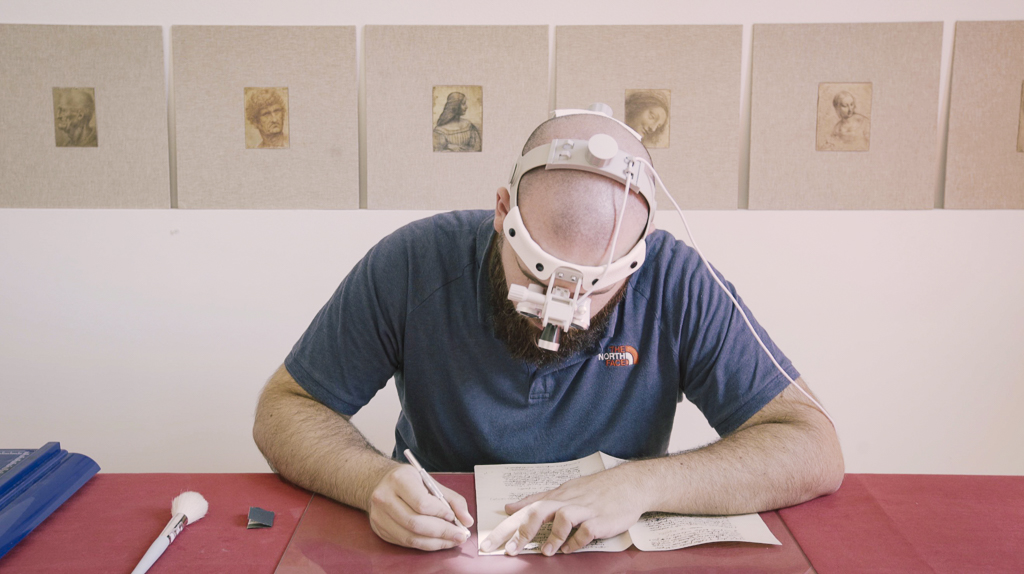About Us
The notes that Leonardo wrote in his manuscripts includes, as we all know, multiple areas of interest: from anatomy to astronomy, from geology to physics, from geometry to war machines, from architecture to even much more.
The observations of the author, written in thousands of pages, are perceived today with understandable and always renewed wonder. Moreover, in his writings, we can always find a hovering part of mystery and in some ways, whether we’re right or wrong, a part of something dark and secret, only to support of his complex and controversial personality. All these feelings are enclosed in his notebooks, which today are perceived as an old and secret chest of wonders.

After years of research, Apocrifa da Vinci managed to create in his laboratory a catalogue of reproductions of Leonardo da Vinci’s manuscripts. These reproductions are entirely hand-made using the paper sculpting technique and then enriched by precious commentaries and handcrafted leather boxes.
Alessandro Tartaglione and his partners developed an exclusive procedure that allows to replicate by hand every detail of every code sheet, replicating in detail all the aspects of the originals.
The incision of the lacerations made with the scalpel, the touch up of the spots and colours with brushes made to underline the details, the natural technique used to antique paper, employed on every single codes sheet and on every drawing are essential steps that allow every specimen to be unique, even though they are the results of the circulation.
The author’s role is very important when it comes to the replica because it conveys to the collective consciousness how it feels to actually leaf through the original pages. The author, through his sensibility and his intervention on the handwritten pages and drawings, creates not only replicas that are different from one another as far as the concept but he also creates replicas that differentiate concretely from the pre-existing copies that were industrially produced.
Apocrifa da Vinci’s main goal was to characterize unequivocally every replica through the sensory involvement of the user: the eyesight is captured by the papers written by Leonardo but also by the processing that was destined to the pages; the touch is stimulated by the roughness and imperfections of the paper; the hearing is stimulated by the ancient and dark sound that is produced when leafing through the pages; the sense of smell is triggered by the slight scent lent to the replicas.
Ultimately, the finished works show aesthetic depth that earns a dimension of resonance because it refers not only to the writing and to the drawings that Leonardo left in his codes, but also to the signs that the passing of time left on the pages.
Alessandro Tartaglione and his partners developed an exclusive procedure that allows to replicate by hand every detail of every code sheet, replicating in detail all the aspects of the originals.
The incision of the lacerations made with the scalpel, the touch up of the spots and colours with brushes made to underline the details, the natural technique used to antique paper, employed on every single codes sheet and on every drawing are essential steps that allow every specimen to be unique, even though they are the results of the circulation.
The author’s role is very important when it comes to the replica because it conveys to the collective consciousness how it feels to actually leaf through the original pages. The author, through his sensibility and his intervention on the handwritten pages and drawings, creates not only replicas that are different from one another as far as the concept but he also creates replicas that differentiate concretely from the pre-existing copies that were industrially produced.
Apocrifa da Vinci’s main goal was to characterize unequivocally every replica through the sensory involvement of the user: the eyesight is captured by the papers written by Leonardo but also by the processing that was destined to the pages; the touch is stimulated by the roughness and imperfections of the paper; the hearing is stimulated by the ancient and dark sound that is produced when leafing through the pages; the sense of smell is triggered by the slight scent lent to the replicas.
Ultimately, the finished works show aesthetic depth that earns a dimension of resonance because it refers not only to the writing and to the drawings that Leonardo left in his codes, but also to the signs that the passing of time left on the pages.
